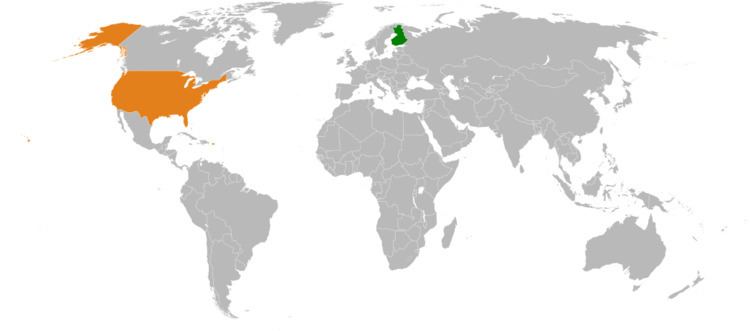 | ||
Finland – United States relations are bilateral relations between Finland and the United States.
According to the 2012 U.S. Global Leadership Report, 48% of Finnish people approve of U.S. leadership, with 34% disapproving and 18% uncertain.
History
Following the Finnish declaration of independence on December 6, 1917, the U.S. government was among the first to recognize it. Diplomatic relations between the two governments were established in 1920 at a legation level.
During the Second World War, as the Finnish government cooperated with the Axis Powers, relations were maintained nevertheless. The U.S. government resisted Soviet pressures to declare war on Finland, but on June 30, 1944, it agreed to sever diplomatic relations with the Finnish government. Following the Finnish withdrawal from the war and Finnish action against German troops in early 1945, the U.S. government reopened its legation in Helsinki on March 1, 1945. On August 20, 1945, negotiations were started between the two governments on re-establishing diplomatic relation, and this was done on August 31.
Relations between the two countries were raised to embassy level on September 10, 1954.
Relations between the United States and Finland are warm. Some 200,000 U.S. citizens visit Finland annually, and about 3,000 U.S. citizens are residents there. The U.S. has an educational exchange program in Finland that is comparatively large for a Western European country of Finland’s size. It is financed in part from a trust fund established in 1976 from Finland’s final repayment of a U.S. loan made in the aftermath of World War I.
Finland is bordered on the east by Russia and, as one of the former Soviet Union’s neighbors, has been of particular interest and importance to the U.S. both during the Cold War and in its aftermath. Before the USSR dissolved in 1991, longstanding US policy was to support Finnish neutrality while maintaining and reinforcing Finland’s historic, cultural, and economic ties with the West. The U.S. has welcomed Finland’s increased participation since 1991 in Western economic and political structures.
Economic and trade relations between Finland and the United States are active and were bolstered by the F-18 Hornet purchase. U.S.–Finland trade totals almost $5 billion annually. The U.S. receives about 7% of Finland’s exports – mainly pulp and paper, ships, machinery, electronics, instruments, and refined petroleum products – and provides about 7% of its imports – principally computers, semiconductors, aircraft, machinery.
Principal U.S. officials include
The U.S. embassy in Finland is in Helsinki.
